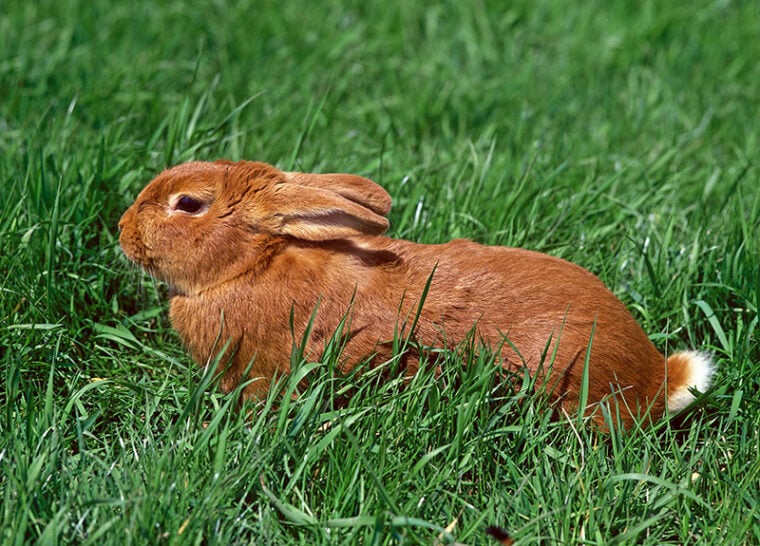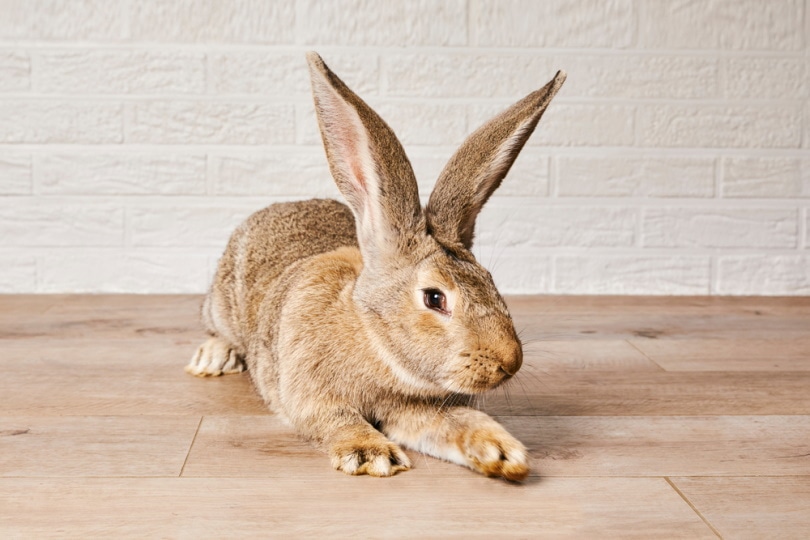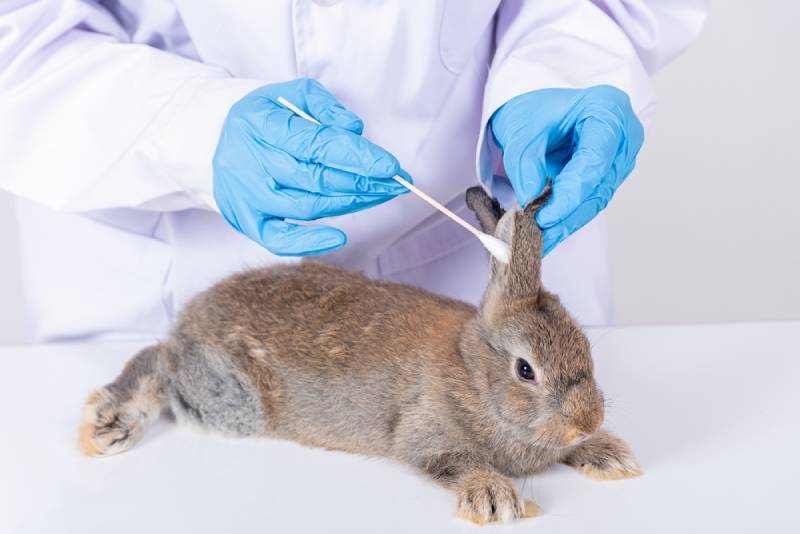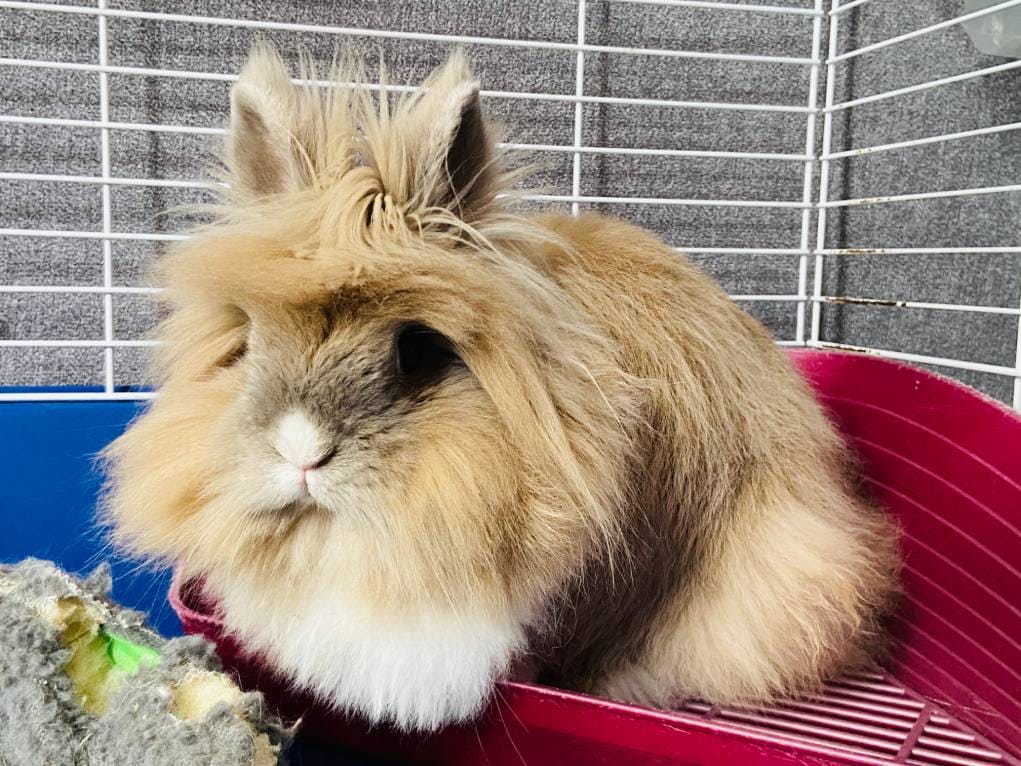
Click to Skip Ahead
Originating from the Burgundy region of France, these stunning rabbits are friendly, intelligent, and docile. In this article, we’ll tell you everything you need to know about Fauve de Bourgogne rabbits, including their average cost, care needs, temperament, and traits, so you can decide if it’s the right breed for you.
| Size: | Medium |
| Weight: | 7–8 pounds |
| Lifespan: | 5–8 years |
| Care Level: | Moderate |
| Minimum Enclosure Size: | 30 x 40 inches |
| Colors: | Russet red |
| Similar Breeds: | Champagne d’Argent, Belgian Hare, English Spot |
| Suitable for: | Experienced rabbit owners, families |
| Temperament: | Friendly, docile, easy to tame |
Originally bred for their striking russet red fur and tasty meat, Fauve de Bourgogne are now loved for their gentle and adaptable nature, making them the perfect family pet rabbit as well as a stunning show breed.
Fauve de Bourgogne Breed Characteristics
How Much Do These Rabbits Cost?
Fauve de Bourgogne rabbits originate from the Burgundy region of France, where they are still commonly kept as both family pets and show animals. Outside of France, this breed becomes more difficult to find. You may be able to buy a Fauve de Bourgogne for $30–$50, however, show rabbits with good pedigree can cost $250 or more.
Another factor that can affect the cost of a Fauve de Bourgogne is the age and general well-being of the rabbit. It’s always best to thoroughly research the breeder’s reputation before making a final decision.
Temperament & Intelligence of the Fauve de Bourgogne
These rabbits are known for their curious, gentle, and friendly nature, making them a great choice for families. They’re also easy to train, and docile. Fauve de Bourgogne are not as active or playful as some other breeds, making them relatively easier to handle and care for.

Do These Rabbits Make Good Pets? 👪
Yes! If you’re looking for a pet rabbit, then Fauve de Bourgogne can make an excellent pet for experienced rabbit owners, single people, and families. They are a medium-sized breed, and—like all pets—they need care, space, and attention.
Like most rabbits, Fauve de Bourgogne can be trained to use a litter box, too. Their docile nature and trainability make them a great choice for a house pet.
Does This Rabbit Get Along With Other Pets?
If properly introduced and always supervised, Fauve de Bourgogne can happily coexist with other pets, including cats and dogs.
Cats are natural predators, and rabbits are prey, so these animals must be introduced carefully for a higher chance of them coexisting peacefully! Generally, it’s better to introduce them while they are both young, but other factors, such as their natural temperaments, will also determine how well they get along.
Similarly, a dog with a low prey drive is much more likely to get along with and accept a rabbit.
Things to Know When Owning a Fauve de Bourgogne:
Food & Diet Requirements 🥕
Your Fauve de Bourgogne will need to be fed a diet of good-quality hay, such as timothy hay or meadow hay. Your baby Fauve de Bourgogne may benefit from alfalfa hay, as it contains a higher amount of calcium and protein to support their growing and developing bones.
Although grazing on hay should make up the majority of your rabbit’s diet, a small amount of fresh vegetables should be provided to them daily. They’ll need around 1–2 cups of vegetables per 4–6 pounds of their body weight. Try to give them a good variety of vegetables, such as dark, leafy greens, squash, bell pepper, cauliflower, and broccoli.
Starchy vegetables, such as carrots, and fruit should only be given to your Fauve de Bourgogne occasionally as a small treat. You should also give your rabbit a small amount of high-quality pellets each day—around 1/4 cup of pellets per 5 pounds of your rabbit’s body weight. Try to avoid pellets that contain added sugar or seeds, and remember not to overfeed your rabbit with pellets, as this often leads to obesity and soft stools.
Remember to always provide your rabbit with fresh drinking water!
Habitat & Hutch Requirements 🏠
You’ll need a rabbit hutch that provides plenty of space for your pet to feel comfortable. Generally, your rabbit will need one square foot of floor space for every pound of their adult weight. Fauve de Bourgogne are medium-sized rabbits that grow to an average weight of 7–8 pounds. With this in mind, you’ll need a hutch that’s around 8 square feet in size. The cage you choose should also be tall enough that your rabbit can comfortably stand on their hind legs without hitting the top of their head.
The ideal rabbit enclosure should provide your rabbit with different areas for sleeping, playing, and eating. Make sure the hutch you install is weatherproof, with good insulation for winter months, as well as good ventilation for the summer.
Finally, your Fauve de Bourgogne will need comfortable, soft bedding to sleep on. Wood shavings, hay, straw, and grass mats are all good options. Whichever you choose, you’ll need to change it regularly to keep it fresh.
An outdoor playpen will give your rabbit an ideal place to run around and get the exercise they need to keep them fit and healthy in a safe, controlled environment. You’ll need to make sure it is escape-proof. A buried wire mesh or solid floor will prevent digging and keep your rabbit safe from predators. Make sure there are shaded and sheltered areas where your rabbit can hide from too much direct sunlight or rain.

Exercise & Sleeping Needs 🐇
Although Fauve de Bourgogne are not as active as some other breeds, they still need plenty of daily exercise to promote good physical and mental health. Let your rabbit run around outside in a secure playpen and provide them with plenty of toys and tunnels for them to play with and explore.
Boredom can lead your rabbit to overeating, and if they eat too much but don’t exercise, this can lead to health issues. Keep your Fauve de Bourgogne on their paws by changing and moving things around from time to time. You can store some toys away and put others out, then swap them again after a few weeks, move their tunnel to a different location, and add additional objects such as empty cardboard boxes.
Rabbits are more active in the early morning, dusk, and night, and they sleep for around 6–8 hours during the day. They’ll need a quiet, comfortable area to sleep inside their hutch, with soft, clean bedding such as hay or straw. Even if you train your rabbit to use a litter box, you’ll still need to change their bedding around once a week to keep it fresh.
Training
Fauve de Bourgogne are naturally docile rabbits, making them great candidates for training. You can train your rabbit to use a litter box by placing one in the corner of their hutch and putting some soiled straw or droppings into the box. As soon as your rabbit uses the litter box, be sure to reward them with a small treat immediately so they learn to associate the behavior with a positive experience!
With patience, consistent positive reinforcement, and time, your rabbit may respond to its name and perform simple tricks such as fetch, jump, and spin, and even run agility courses.

Grooming ✂️
Fauve de Bourgogne are known for their beautiful fur, which needs regular brushing to keep its health and luster. To prevent matting, you’ll need to brush your Fauve de Bourgogne at least once a week using a soft-bristle brush. You may need to brush your rabbit several times a week during shedding seasons. You can also use a flea comb to brush through your rabbit’s coat as part of a flea-prevention strategy.
As well as brushing, you’ll need to clean your rabbit’s eyes and ears. Trimming their nails around once a month using a pair of animal nail clippers will help prevent torn nails and nail bed and toe infections.
Regular, careful grooming is essential to keeping a healthy, happy Fauve de Bourgogne. It’s also the perfect opportunity to bond with your pet and look out for any potential health issues. If you spot fleas, ticks, or mites, make an appointment with your vet to get the issues solved quickly.
Lifespan and Health Conditions 🏥
On average, Fauve de Bourgogne live to around 5–8 years, though with proper care and attention, some rabbits may live longer. To ensure your rabbit lives a full, happy life, provide them with a well-balanced diet, plenty of exercise, an adequate grooming routine, and regular check-ups with your vet.

Serious Conditions:
Snuffles
Rabbits are prone to upper respiratory bacterial infections, collectively referred to as “snuffles.” They cause a range of cold-like symptoms, including runny eyes and nose, coughing, sneezing, and possibly breathing difficulties. Your rabbit will probably have a reduced appetite, and a blocked nose.
Snuffles are a serious condition that can be life-threatening. If you suspect your Fauve de Bourgogne has it, you should take them to a vet as soon as possible. Treatment usually involves a prolonged course of antibiotics.
To reduce the chance of your rabbit catching snuffles, clean their hutch often to remove bacteria and dirt, provide good ventilation, and make sure their hutch is dry and watertight.
Gastrointestinal (GI) Stasis
GI stasis in rabbits is a serious condition that causes the overgrowth of painful gas and toxin-producing bacteria in the gastrointestinal tract when the digestive system slows down or stops entirely. Though it is a common condition in rabbits, it can be fatal if left untreated. When diagnosed early, GI stasis is usually treatable with motility-enhancing medication and IV feeding.
Dental Disease
Your rabbit’s teeth will grow continuously, but they usually wear down as they gnaw on their food. Occasionally, overgrown teeth can be the result of an improper diet or the lack of chewing material, though it can sometimes be inherited. To prevent overgrown teeth, provide your Fauve de Bourgogne with plenty of good quality hay, and chewing material such as bamboo, willow, or chew toys, and take your pet for regular checkups with a veterinarian.
Uterine Tumors
Up to 70% of unspayed adult female rabbits go on to develop uterine cancer. If caught early, it may be treated surgically through spaying. Additionally, uterine infections may require spaying. To avoid these issues, it’s best to spay your Fauve de Bourgogne when they are around 6 months old.
Minor Conditions:
Ear Mites and Fleas
Small parasite infestations such as fleas and ear mites are common health issues for rabbits. A regular, thorough grooming routine will help you spot and root out the problem early before they cause secondary issues.
Ear mites infest a rabbit’s ears, and cause itching and irritation. When cleaning your rabbit’s ears, you may notice discharge or crusting. If your rabbit is shaking their head or scratching their neck, cheeks, or ears excessively, this could be a sign of ear mites. Your veterinarian will be able to prescribe medication to help eradicate ear mites.
As outdoor animals, rabbits are prone to flea infestations. Check your rabbit’s coat while brushing. If you spot fleas, you can use a flea comb to remove and drown them. Additionally, your veterinarian will be able to recommend rabbit-friendly flea ointments to help get rid of the problem without harming your pet.
Overgrown Nails
Ideally, you should trim your Fauve de Bourgogne’s nails monthly. Overgrown nails will make it uncomfortable for your rabbit to walk, and they can catch on objects, tear, and lead to infections in the toes and nail beds. The issue is easily preventable by trimming your rabbit’s nails once a month, using a pair of animal-safe nail clippers.
Male vs Female
You won’t notice much of a difference between male and female Fauve de Bourgogne. Both sexes are equally friendly, docile, gentle, and beautiful. If you do get a female Fauve de Bourgogne, it’s essential that you get them spayed when they are young to avoid health issues when they get older.
The 3 Little-Known Facts About Fauve de Bourgogne
1. Fauve de Bourgogne was officially recognized as a breed in 1928.
2. They were developed through the selective breeding of fawn-colored rabbits.
3. Fauve de Bourgogne are known for their beautiful russet-red medium-length fur.

Final Thoughts
Fauve de Bourgogne rabbits are known for their beautiful russet-red coat. These medium-sized bunnies are gentle and intelligent, making them the ideal pet for experienced rabbit owners, and families alike. Their docile nature makes them easy to train, and great to interact with. Provide them with a balanced diet, regular grooming, and adequate, clean living quarters, and these lovable rabbits will return your kindness with endless entertainment!
Featured Image Credit: slowmotiongli, Shutterstock








